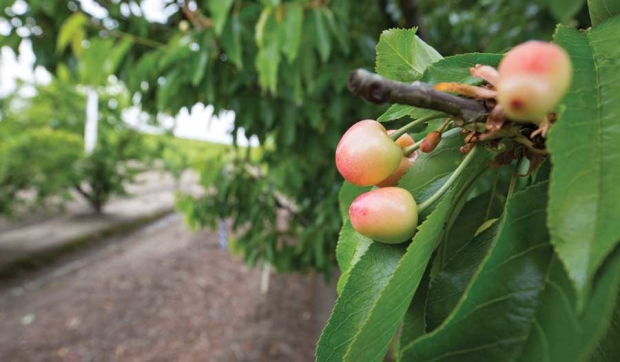
Although many Northern California cherry orchards had a strong bloom, fruit set is spotty and appears related to whether the flowers were open during cool weather or during record heat. (TJ Mullinax/Good Fruit Grower)
California’s sweet cherry crop appears to have rebounded this season from a disastrous 2014, although production still lags behind that from earlier this decade.
Many blamed warm temperatures and erratic chilling during the 2013-14 winter for last year’s poor production, which was 63 percent less than the 9.1 million boxes harvested in 2013. The 2014 crop also was the smallest since 1998, according to the National Agricultural Statistics Service.
This year, Stemilt Growers LLC, which is based in Wenatchee, Washington, and owns Chinchiolo Stemilt California LLC in Stockton, California, expected to pack about 750,000 boxes from California, said Brianna Shales, communication manager.
Once again this year, weather appears to have played a role in yields of early season varieties in the southern San Joaquin Valley near Arvin, Shafter, and Bakersfield.
Preseason estimates for southern orchards owned by Stemilt or that ship through Stemilt indicated that production of the Brooks variety could be only 50 percent of average, she said. The Coral Champagne crop appeared to be about 60 percent of average, whereas the Tulare crop appeared only about 15 percent of average, Shales said.
Steve Murray, owner of Murray Family Farms in Arvin, blamed inadequate chill for impacting south-valley orchards.
Chill portions
Cherries require about 48 chill portions for adequate bloom and fruit set. A relatively new concept, chill portions are based on a dynamic model that takes into account chill cancellation due to fluctuating warm temperatures.
“When you get down into Arvin and Maricopa, nobody got to 45 or 48 chill portions, so I think everybody has a light crop,” he said.
Growers who applied a plant growth regulator early and whose trees bloomed early appeared to have better fruit set than those who sprayed later or whose trees bloomed later during record heat.
Those with the earliest trees were expected to begin harvest by mid-April, compared with a typical start of April 23-25, Murray said.
On his own ranch, Murray has more than two dozen cherry varieties. About a half dozen are sold commercially, with the others designed to stretch the season for direct-to-consumer sales.
His crop this year was smaller than last year, which he said was bucking the trend.
“Last year was a disaster industrywide, whereas this year I’d say was a disaster for orchards in the south and north and a better crop in the middle because of when they were blooming,” Murray said. “Usually we have some blocks that will pull through, and this year we just don’t have any blocks that will pull through.”
One of his worst performers is the Tulare variety. Only a few years ago, he could count on harvesting 35,000 boxes of the variety. This year, he won’t even pick 3,000 boxes.
“The last three years, it just doesn’t seem to set any crop,” he said. “There was a time when it was insurance—one that would always set a good crop.”
Production around Patterson in central California also appeared down, with Coral and Hazel—a newer variety—about 60 percent of average, Shales said of Stemilt production. The Garnet crop was about half of average, she said.
Not promising
Chris Britton, a partner in BK Partners Inc. in Modesto, said this year’s crop didn’t look promising at all.
Fruit set on his Coral Champagne, Brooks, and Bings looked adequate, while Chelan, Garnets, and Tulares were extremely light.
Britton guessed his crop was about 25 percent of what he’d consider normal. Last year, the set was so light at about five percent he didn’t even harvest.
Heading into this spring, Britton had been optimistic.
“We had a terrific snowball bloom this year, and we all thought things looked great,” he said. “But for whatever reason, whether it was heat or some unknown factor, the set’s just not there.”
During the winter, they even ran overhead irrigation and applied Surround to try to keep the trees cool.
“We had what we would consider adequate chill, so I don’t think it’s that,” he said.
Some theories point to heat during bloom. Britton said the temperature hit close to 90 degrees a couple of times when the flowers were open.
In the northern production area around Stockton and Lodi, Shales said the crop load was spotty in some orchards and nice in others.
Shales said she expected harvest to begin a few days earlier than normal in the southern production area and end in the Lodi-Stockton area in early June. Speaking before the start of the season, Shales said she expected a nice transition to Washington without a supply gap or oversupply.
“The harvest in California will wrap up around June 6 with Lapins and Sweetheart. That will be right as Washington starts to ramp up,” she said.
Jim Ferrari, who has mostly Bings near Linden, said this year’s crop definitely looked better than last year, when it was light.
“It’s just a matter of luck—it’s not a matter of proficiency or anything else,” Ferrari said.
In looking at orchards in the area, he said fruit set appeared related to when trees bloomed.
“If the cherries bloomed earlier when it was a bit cooler, they seemed to set better,” he said. “If they bloomed a little later when the temperatures were higher, the set is off.”
Even within the same variety, Ferrari said he’s seen variations in set.
Maturity was running about a week ahead of last year, and Ferrari said he expected to have Bings before Memorial Day.
He hoped to complete harvest by the end of May.
“In this area of California, if we can get out before there’s a hint of Washington coming in, we’re in good shape,” he said. “We kind of shoot for the end of May to get out before they come in.” •






Leave A Comment